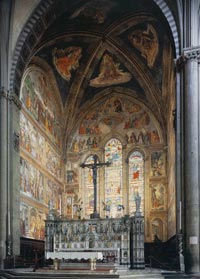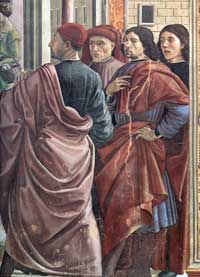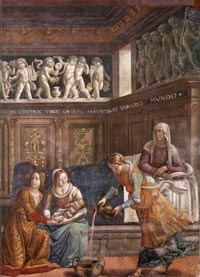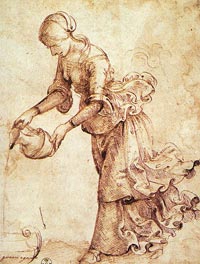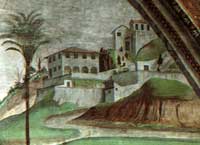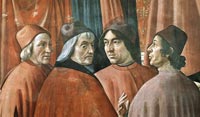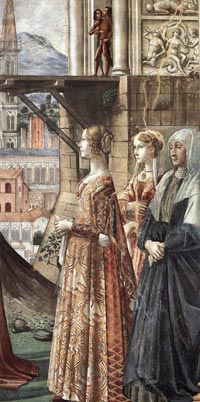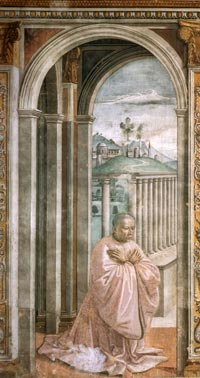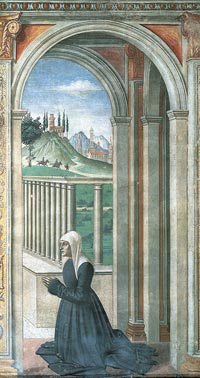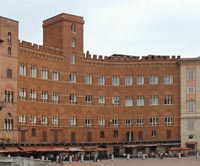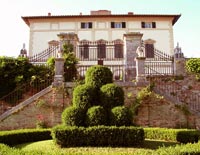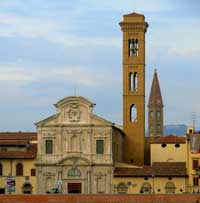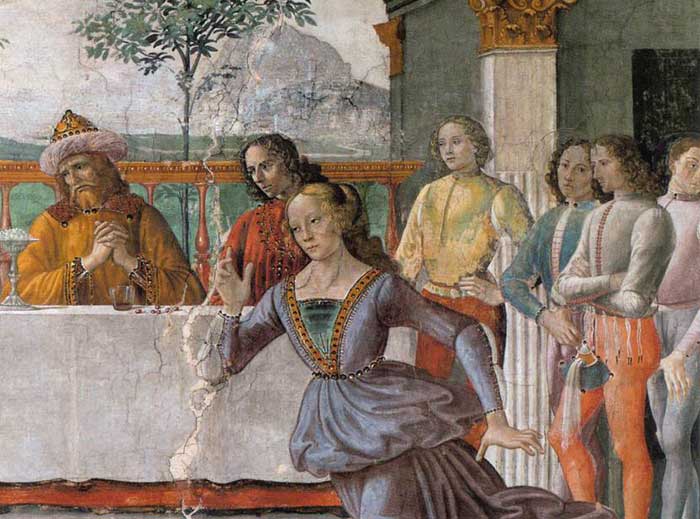 |
|
Domenico Ghirlandaio, Herod's Banquet, (detail), fresco in the Cappella Tornabuoni, Santa Maria Novella, Firenze |
|
Domenico Ghirlandaio | The Tornabuoni Chapel |
The Cappella Tornabuoni is the main chapel (or chancel) in the church of Santa Maria Novella, Florence, Italy. It is famous for the extensive and well-preserved fresco cycle on its walls, one of the most complete in the city, which was created by Domenico Ghirlandaio and his workshop between 1485 and 1490. |
||
Giovanni Tornabuoni was one of the wealthiest and most influential men in Florence, tied to the Medici by links forged by marriage, business and political interests. His sister Lucrezia was the wife of Piero de Medici and the mother of Lorenzo the Magnificent. Ghirlandaio worked to the frescoes from 1485 to 1490, with the collaboration of his workshop artists, who included his brothers Davide and Benedetto, his brother-in-law Sebastiano Mainardi and, probably, the young Michelangelo Buonarroti. The windows were also executed according to Ghirlandaio's design. The complex was completed by an altarpiece portraying the Madonna del Latte in Glory with Angel and Saints, flanked by two panels with St. Catherine of Siena and St. Lawrence. On the recto a Resurrection of Christ was painted. This work is now held divided between the Gemäldegalerie, Berlin and the Alte Pinakothek, Munich. |
||
![Domenico Ghirlandaio: Zachariah in the Temple [detail]: four humanist philosophers under the patronage of the Medici:](/images/art/ghirlandaio/zachariah1700.jpg) |
||
Domenico Ghirlandaio: Zachariah in the Temple [detail]: four humanist philosophers under the patronage of the Medici: Marsilio Ficino, Cristoforo Landino, Angelo Poliziano and Demetrios Chalkondyles, 1486-1490, fresco in the Cappella Tornabuoni, Santa Maria Novella, Florence |
||
Scenes from the life of the Blessed Virgin Mary
|
||
The Expulsion of Joachim
|
||
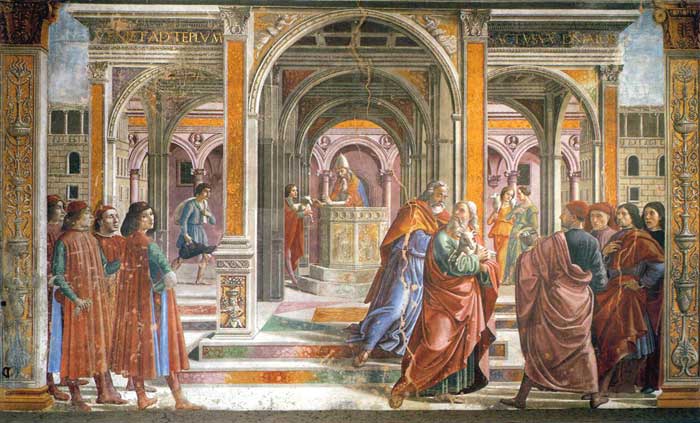 |
||
Domenico Ghirlandaio, The Expulsion of Joachim from the Temple, fresco in the Cappella Tornabuoni, Santa Maria Novella, Firenze |
||
| The first episode represents the expulsion of Joachim, the father of Mary, from the Temple of Jerusalem. A ceremony is taking place in which several figures are carrying lambs for sacrifice. However, Joachim was banned from attending due to his alleged sterility. Ghirlandaio set the scene in a sumptuous loggia of Greek cross plan, with a sequence of arches in the background and an octagonal altar in the middle, where the sacrificial fire is lit. The characters are illuminated from above, as if by the natural lighting from the real chapel windows. Two groups of Florentine people, representing the populace, are shown to the sides of the scene. They wear contemporary fashionable clothes (for which the frescoes are a famous source), unlike the main biblical figures, who wear the usual "iconographic costume". On the left, two figures may be identified as Lorenzo Tornabuoni, son of Ghirlandaio's patron, and Piero di Lorenzo de' Medici, the former's friend. In the righthand group is a self-portrait of the artist with some of his relatives. The loggia in the background could be a representation of the Ospedale di San Paolo (St. Paul's Hospital), which was then under construction in the same square as Santa Maria Novella. The two buildings on the sides are examples of typical edifices of 15th-century Florence, characterized by rustication and an upper loggia.
|
||
The Nativity of Mary
|
||
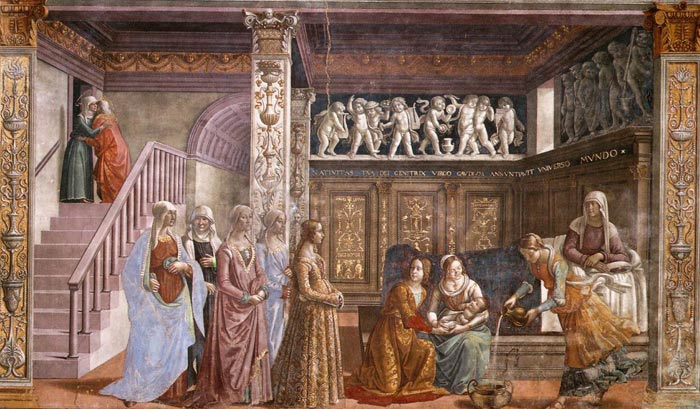 |
||
Domenico Ghirlandaio, The Nativity of Mary, fresco in the Cappella Tornabuoni, Santa Maria Novella, Firenze |
||
| "The second scene is the Nativity of the Virgin, executed with great diligence. Among other remarkable things it contains a window which lights the chamber and actually deceives the beholder..." (Vasari). The second scene portrays the Nativity of Mary, set in a luxurious room with inlaid wooden panelling surmounted by a frieze in bas-relief of music-making putti and a cornice of winged cherubs. The room is divided by piers decorated in relief. To the left, near the door at the top of the stairs is shown symbolically an early incident of the story, the embrace of Anne and Joachim at the Golden Gate of Jerusalem. To the right, St. Anne reclines in bed, while three young women prepare to bath the new-born Mary. The nurse who is pouring water into a basin is the only figure in the room to be moving rapidly. Her flowing robes and swirling scarf make her an iconic motif to be found in many painings both by Ghirlandaio and other painters and sculptors of the period. A preparatory drawing of this woman has been preserved in the Cabinet of Prints and Drawings of the Uffizi. |
||
The Presentation at the Temple
|
||
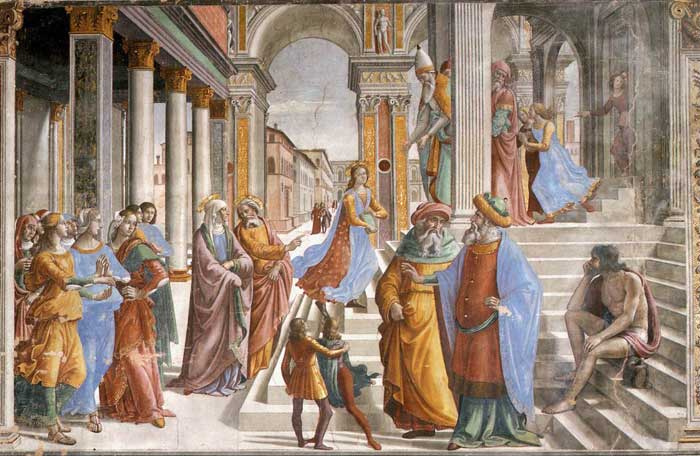 |
||
Domenico Ghirlandaio, The Presentation at the Temple, fresco in the Cappella Tornabuoni, Santa Maria Novella, Firenze |
||
| The Presentation at the Termple is a complex composition, with numerous characters placed on different levels. In the centre, the young Mary, holding a book, is ascending the Temple's staircase towards the priest, but is looking in the viewer's direction. Her awkward posture is perhaps intended to suggest her young shyness, but the figure appears rather awkward. The role and meaning of the other figures who crowd the classical architectures of the scene are still partly unclear. The female figures on the right, portrayed with notable attention to detail, are probably portraits of real contemporary women. Next to them are St. Anne and Joachim, distinguishable by aureolas, who point at their daughter Mary. Two young women, painted by workshop collaborators, are rushing out from the Temple. The two small figures in the centre foreground have not been identified. They could be children, but have adult features. It has been suggested that, being observed from below, they acquire a more youthful appearance, so their unusual rendering could be a technical trick by Ghirlandaio. The symbolic role of the nude man sitting on the steps, on the right, is unknown. Next to him are two old men.
|
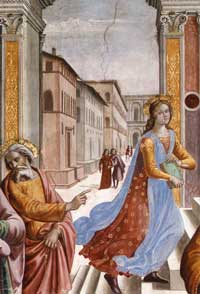 |
|
The Marriage of the Virgin
|
||
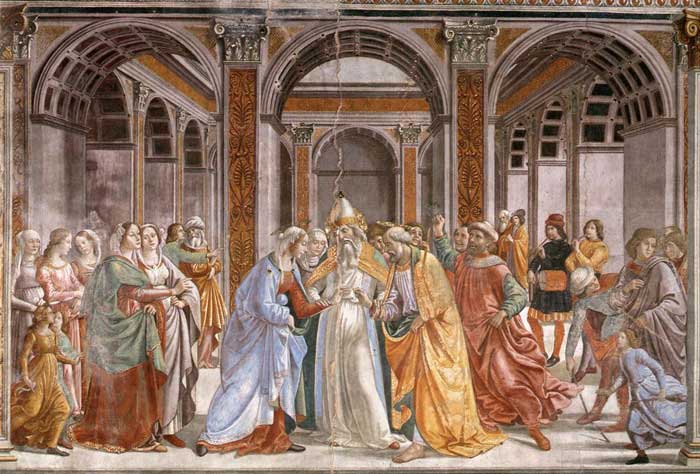 |
||
Domenico Ghirlandaio, The Marriage of the Virgin, fresco in the Cappella Tornabuoni, Santa Maria Novella, Firenze |
||
| The Marriage of the Virgin is set in beautiful Renaissance architecture, while the composition of the scene is rather traditional. In the centre is the temple priest, with the same features as in the Presentation. He is sealing the marriage between Joseph and Mary. To the sides are two processions, with men on the left and women on the right. Some of the former, angry at having not been chosen to marry Mary, are shown while breaking their sticks or raising their fists (a story originating in apocryphal legends of the life of Mary). Joseph's club, which had been chosen as the most vigorous, is barely visible over his shoulder. Most of the portraits are summary in style, apart some very carefully executed ones near the priest.
It is not clear if the shorter figures in both lower corner are children or have a different symbolic meaning. A preparatory sketch for this scene has been preserved in the Gabinetto dei Disegni e Stampe in the Uffizi, in which the priest in the centre is absent.
|
||
The Adoration of the Magi
|
||
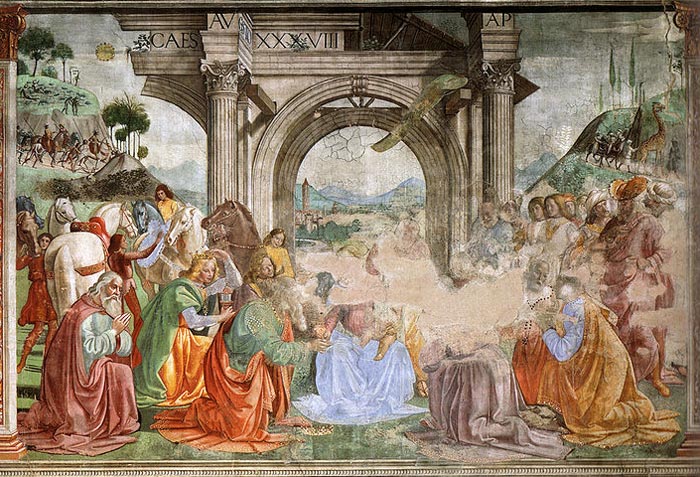 |
||
Domenico Ghirlandaio, fresco in the Cappella Tornabuoni, Santa Maria Novella, Firenze |
||
| In several details this scene resembles the version in the Sassetti Chapel (also produced by Ghirlandaio), for example in the ruins and the hills which the Magis' procession is crossing. It is the most damaged section of the cycle, having lost much of the intonaco in the central area.
Mary and the Child Jesus are in the centre, framed by an arch with the inscription: CAES[AR] AUGUSTO XXXVIII AP. The Magi are finely executed: the younger one on the left in particular, who is already taking off his crown as a sign of deference. The peacock on the arch is a symbol of the Resurrection. The men on the right, whose clothes suggest that they could be foreign ambassadors, are most likely portraits of Ghirlandaio's contemporaries. In the procession on the righthand hill a giraffe rendered with noteworthy realism can be seen (a giraffe had been presented to Lorenzo de' Medici and brought to Florence in 1486).
|
||
Massacre of the Innocents
|
||
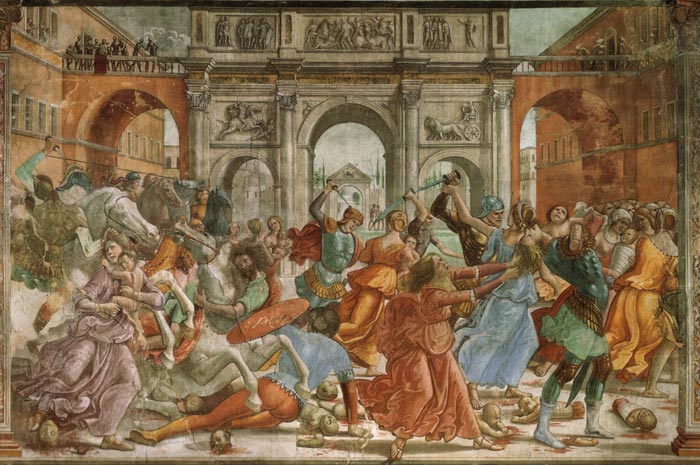 |
||
Domenico Ghirlandaio, fresco in the Cappella Tornabuoni, Santa Maria Novella, Firenze |
||
The scene Massacre of the Innocents was the one that Vasari, in his biography of Ghirlandaio, considered the best in the cycle, due to its dramatic and frantic composition. It is probable that Ghirlandaio was inspired by scenes of ancient Roman bas-reliefs, like that depicted on the arch in the background.On the vault (the ceiling) of the chapel the four Evangelists were depicted. The right wall was dedicated to the life of St John the Baptist, and the left wall shows scenes from the life of Mary. Ghirlandaio also designed the rear wall. The panels on that wall have been dispersed over several collections, but the stained glass windows are still present.
|
||
The Death and Assumption of the Virgin
|
||
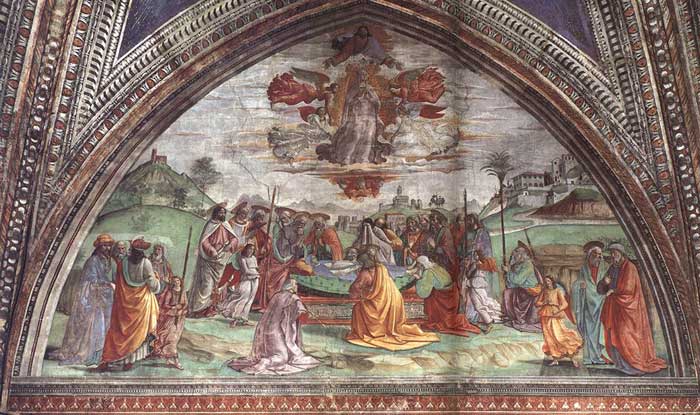 |
||
Domenico Ghirlandaio, The Death and Assumption of the Virgin, fresco in the Cappella Tornabuoni, Santa Maria Novella, Firenze |
||
| The left wall cycle culminates in the large lunette with the scene of Death and Assumption of the Virgin. The painting quality of this picture looks inferior to the rest, showing that Ghirlandaio left most of its execution to his workshop. The body of the aged Virgin is lying on a lawn, surrounded by the Twelve Apostles who kiss her feet in a sign of deference, cry and pray. Angels are holding torches, while one of the Apostles holds a palm, a symbol of Resurrection. In the upper part of the painting the Virgin is shown again, young and attractive, within an mandorla supported by angels. God is welcoming her. In the background are hills with castles, fortified towns and (on the right) a villa, which is the Villa Medici in Fiesole. The story of Mary ends in the central wall's lunette with the Coronation of the Virgin. The cycle joins that of John the Baptist in the scene of the Visitation.
|
||
Scenes from the life of St. John the Baptist
|
||
| The Apparition of the Angel to Zechariah |
||
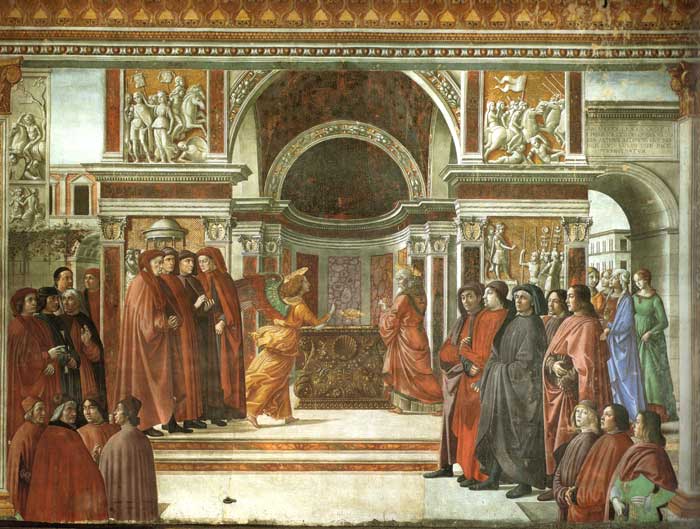 |
||
Domenico Ghirlandaio, The Apparition of the Angel to Zechariah, fresco in the Cappella Tornabuoni, Santa Maria Novella, Firenze |
||
| Like the others in the lower wall, this scene is one of the best in the cycle. The Biblical episode of the apparition of the Angel to Zechariah is portrayed within magnificent Renaissance church architecture. Zechariah is portrayed on the altar in the centre, with the Angel Gabriel suddenly appearing on his left to announce to him that he will have a son. The scene is crowded with six groups of characters on six different levels. Aside from the group of six maidens on the right, the others are all portraits of contemporary Florentine notables. On the lower left are the Renaissance humanists, including Cristoforo Landino (the one with a black collar) and Agnolo Poliziano (the second from right). The figures standing on the right are relatives of the patron; behind them is a self-portrait of Ghirlandaio (the second from right, next to a youngster with long hair, probably his son or brother, who is also present in the Expulsion of Joachim). The inscription on the arch at the left celebrates the completion of the cycle (in 1490), and has a quote by Agnolo Poliziano. The Classical-style altar resembles that painted by Leonardo da Vinci in his Annunciation.
|
||
The Visitation |
||
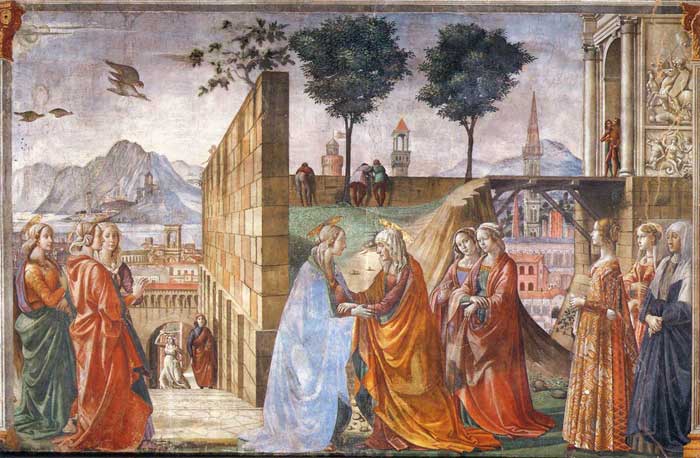 |
||
Domenico Ghirlandaio, The Visitation, fresco in the Cappella Tornabuoni, Santa Maria Novella, Firenze |
||
| This scene portrays the meeting of Mary with the aged Elizabeth. The complex composition includes in the centre the key episode, the relevance of which is strengthened by the converging lines of the a wall in perspective and a ravine in the background. Behind Elizabeth are two maidens, while on the two extremities are other groups of women. The group on the right include portraits of contemporaries: the first, in profile, is Giovanna degli Albizzi, who had married Giovanni Tornabuoni's son. Vasari wrongly identified her as Ginevra de' Benci. The fine background shows the influence of both classical and Flemish art on Ghirlandaio. On the right is an ancient edifice, while the city landscape on the right is typical of Early Netherlandish painting. The balcony in the middle with two young men stretching out is probably a reference to Jan van Eyck's Madonna of Chancellor Rolin, or to Rogier van der Weyden's St. Luke Painting the Madonna. Two other figures are portrayed walking upwards next to the dividing wall. The city is fanciful, but details like the tower of Florence's Palazzo Vecchio and the Santa Maria Novella campanile, as well as Rome's Colosseum are from real buildings. All the elements in this picture were explicitly required in Tornabuoni's contract with Ghirlandaio: the landscape, the city, the animals, the perspective, the portraits and the classical elements.
|
||
The Birth of the Baptist |
||
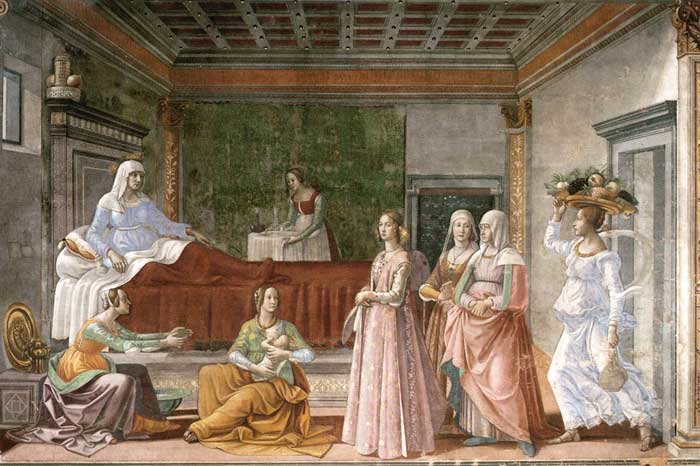 |
||
Domenico Ghirlandaio, The Birth of the Baptist, fresco in the Cappella Tornabuoni, Santa Maria Novella, Firenze |
||
| This scene is linked with that in the opposite wall, the Birth of the Virgin, with which it shares an element of composition having the bed placed symmetrically. This room is less luxurious than the other, but still probably portrays that of a rich Florentine merchant of the time. The light falls heavily on the figures in the foreground, while the others are partially in shade. Elizabeth is depicted on the bed in a calm and majestic posture, with a book in her left hand. As in the other scene, there are two nurses painted with brilliant colours to attract the watcher's attention. Three women, also in the foreground, are visiting Elizabeth. The first, luxuriously dressed, could be a relative of the Tornabuoni. Of the two other figures, the older is most likely Lucrezia Tornabuoni, Giovanni's sister, who had recently died. The maid entering from the right with a basket of fruit on her head resembles both one of the nymphs of Botticelli's Primavera and the Salome painted by Filippino Lippi in the Prato Cathedral. In a preparatory drawing now in the Gemäldegalerie, Berlin the maid is in fact Salome carrying the Baptist's head. Notable is the attention to domestic detail, which shows again the influence on Ghirlandaio of the Netherlandish school, which was being felt in Tuscany during this period: the two bottles of wine and water held by the maid, the bed-frame with a vase and the two pomegranates over the bed. |
||
|
||
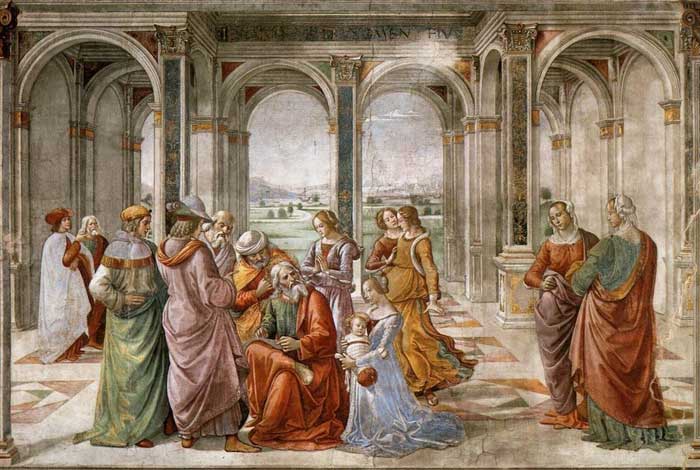 |
||
Domenico Ghirlandaio, Zechariah Writes John's Name, fresco in the Cappella Tornabuoni, Santa Maria Novella, Firenze |
||
| This scene depicts the moment in which Zechariah, now mute, writes his new son's name on a sheet of paper. It is set under a large portico, which opens on a magnificent landscape created according to aerial perspective. The main scene is in the middle, with Zechariah sitting and looking at his son, who is held in Elizabeth's arm. The figures on the left are symmetrically balanced by a group of two women on the right: this composition allowed the child to appear exactly in the middle of the scene, aligned with the central pilaster of the portico. Behind Zechariah are two old men, while a younger figure, in contemporary clothes, is portrayed from the back. The Gabinetto delle Stampe e dei Disegni of the Uzzi houses a preparatory sketch for the women on the left.
|
||
John preaches in the wilderness |
||
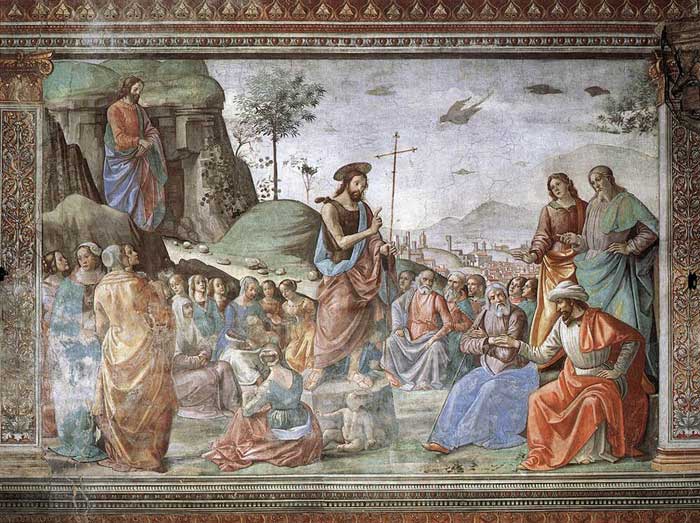 |
||
Domenico Ghirlandaio, Predication of the Baptist, fresco in the Cappella Tornabuoni, Santa Maria Novella, Firenze |
||
| In this scene John the Baptist is portrayed in the centre, on a rock, while instructing a crowd who form a circle around him. He wears the camelskins mentioned in the Gospels and is pointing at the cross. A listening Jesus can be seen on the path in the upper left corner.
As often with Ghirlandaio there is a group of women on the left. Of particular interest are the woman sitting in the centre, and the child at John's feet. The execution of the other figures is rather hasty, and is most likely by the artist's workshop, as are many other details in the scenes of the upper chapel walls. |
||
The Baptism of Christ
|
||
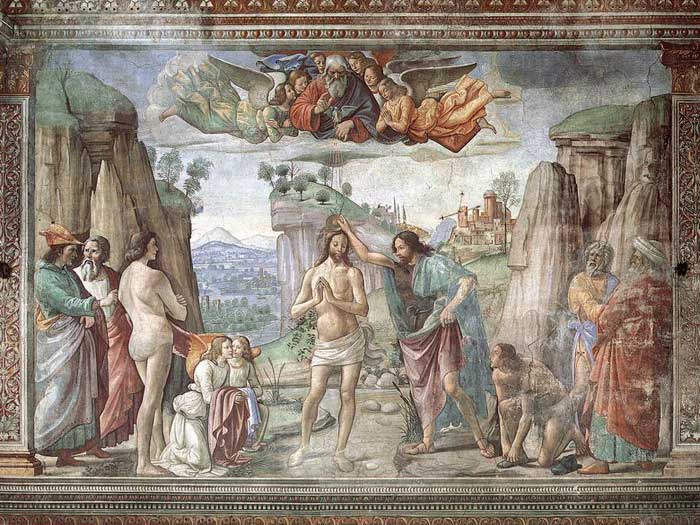 |
||
Domenico Ghirlandaio, Baptism of Christ, fresco in the Cappella Tornabuoni, Santa Maria Novella, Firenze |
||
| The scene of the baptism follows a traditional scheme: for example, the naked man resembles that of Masaccio's Brancacci Chapel, while the Christ is similar to the panel by Verrocchio and Leonardo at the Uffizi.
Notable is the figure of the kneeling man on the right, who is removing his shoes while looking with curiosity at the scene, while traditional portrayal is again seen with God giving his blessing between the angels, in the upper area, which is in a quasi-Late Gothic style. The graceful landscape in the background is divided by a spur which creates a frame around Christ's figure. The two pairs of figures at the sides, again hastily painted, were executed by Ghirlandaio's workshop following his design. |
||
|
||
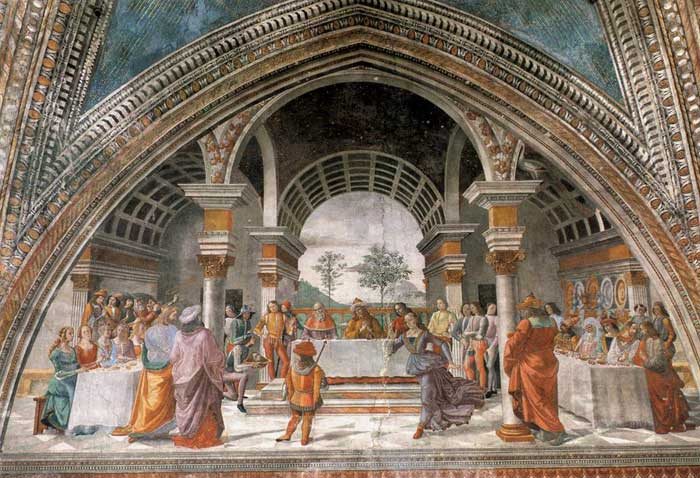 |
||
Domenico Ghirlandaio, Herod's Banquet, fresco in the Cappella Tornabuoni, Santa Maria Novella, Firenze |
||
| The scene of Herod's banquet concludes the story of St. John the Baptist. It is set within a majestic, classical-style hall with a painted arch. The barrel vault resembles that of the Basilica of Maxentius in Rome. Two tables along the sides underline the perspective-based composition: the women sit at the left one, while the men are seated at the right. Behind the women is a group of musicians.
At the table in the centre is Herod, with an open window behind him. In the foreground Salome is portrayed performing her dance. Other men (including a dwarf) are looking on the left, where a servant is handing over John's head to Herod. A man nearby is making a gesture of disgust at the sight. The scene is inspired by the work of Filippo Lippi in Prato Cathedral, but is of lesser dramatic quality; the artwork was most likely provided by Ghirlandaio's workshop almost entirely. |
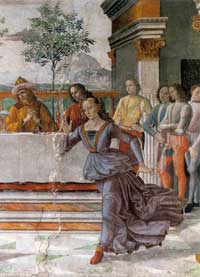 |
|
|
||
| On the middle wall are portrayed the following scenes:
* Coronation of the Virgin and Saints' (lunette)
In the groin-vault are four Evangelist portraits; they write or show their work (apart St. Mark, who is cutting his pen with a knife), flanked by their symbols. In reference to the figure, they are: * St. John the Evangelist (1 yellow) Giovanni Tornabuoni was an Italian merchant, banker and patron of the arts from Florence. |
||
[1] In 1444, ten years after he had begun the consolidation of power that would make him the "first citizen" of republican Florence, the merchant-banker Cosimo de' Medici married his 28-year-old son Piero to 19-year-old Lucrezia Tornabuoni, from one of the oldest and most respected Florentine families. Her father was a colleague of Cosimo, but he also represented a link to the old nobility of Tuscany. |
||
Wikimedia Commons has media related to Domenico Ghirlandaio and the Cappella Tornabuoni, the main chapel (or chancel) in the church of Santa Maria Novella, Florence. |
||
This page uses material from the Wikipedia articles Domenico Ghirlandaio and Tornabuoni Chapel, published under the GNU Free Documentation License, and excerpts from Paola Tinagli, Women in Italian Renaissance Art: Gender, Representation, Identity (Manchester, 1997). |
||
Santa Maria Novella, Florence | On a commission from Giovanni di Paolo Rucellai, a local textile merchant, Leone Battista Alberti designed the upper part of the inlaid black and white marble facade of the church (1456–1470). |
||||
Holiday accomodation in Tuscany | Podere Santa Pia | Artist and writer's residency
|
||||
Podere Santa Pia |
Podere Santa Pia, garden view, April |
View from Podere Santa Pia
on the coast and Corsica |
||
Siena, Palazzo Sansedoni |
Florence, Chiesa di Ognissanti |
|||
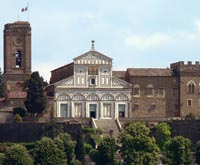 |
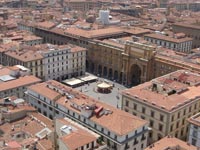 |
|||
Florence, San Miniato al Monte |
Florence, Duomo |
Florence, Piazza della Repubblica |
||
Wikimedia Commons has media related to Santa Maria Novella, the Cappella Tornabuoni |
||||

